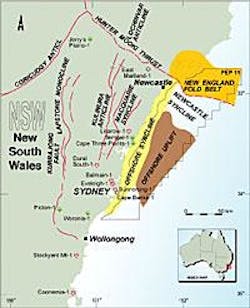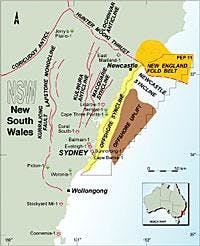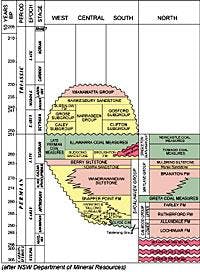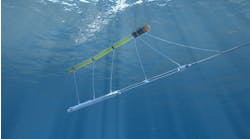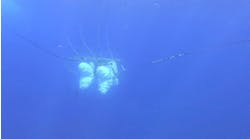By Laurence Roe
Bounty Oil & Gas NL
The Permo-Triassic offshore Sydney Basin is a totally untested but highly prospective basin situated along the heavily populated and industrialized central coast of New South Wales, Australia. No drilling has taken place in the basin, despite a significant number of wells drilled in the adjacent onshore Sydney Basin, which have flowed gas or encountered oil shows.
Offshore Sydney Basin contains major structural elements of folding and uplift.
Covered by PEP 11, a 125-mi-long, 2 million-acre permit, the offshore Syd-ney Basin is a significant exploration area, with large scale structuring and potentially multi-tcf gas and condensate-charged Triassic and Permian reservoirs. Mapped prospects and leads are generally located less than 30 mi from Australia's largest energy market, the Sydney-Wollongong-Newcastle greater metropolitan area - a population center of 5 million people.
Geologic setting
The initial tectonic framework of the offshore Sydney Basin was that of a foreland basin, created by the propagation of active thrust fronts associated with subduction during the Late Carboniferous and the Early Permian periods. A major compressional event in the mid-Permian reoriented the foredeep axis in an approximate east-west direction. This 90° shift across the former regional tectonic axis caused arching of the slightly older offshore uplift within the central and southern part of the offshore basin and superimposed the younger Newcastle syncline in the north.
Foreland tectonism throughout the Late Permian and Early Triassic continued the development of the offshore uplift as a major fold while it was progressively onlapped by Permian coal measures and marine sands and later by Triassic sandstones. Compression continued into the earliest Late Triassic and was followed by extensions and burial in the Jurassic and Early Cretaceous. A phase of uplift and arching later stripped off much of the earlier Mesozoic sedimentary cover and redeposited this material into the incipient Tasman Sea rift.
Offshore syncline
This area is manifested as a pronounced north-south trending feature, immediately east of the present coastline, containing both Permian and Early Triassic sediments. It represents a compressional downwarp or foredeep generated by the thrust loading associated with the emplacement of the offshore uplift, which forms its eastern flank.
The basin is of Permian-Triasssic age with alternating coal measures and sandstones.
The offshore syncline contains Early Permian sediments of the Shoalhaven Group, which is composed of a coal measure section equivalent in age to the Clyde Coal Measures and the younger Greta Coal Measures. It also contains mudstones and reservoir sandstones.
The Late Permian section is represented by equivalents of the onshore Illawara Coal Measures, which contain the Tomago and Newcastle Coal Measures. Sandstones and claystones of the Triassic Narrabeen Group directly overlay the Newcastle Coal Measures. The Narrabeen Group is succeeded by the basin-wide Hawkesbury Sandstone of Middle Triassic age and in turn is succeeded by the regional sealing unit of the Wianamatta Group - the Ashfield Shale.
The Late-Early Permian coal measures and related sandstone/shale pairs represent a thick section of complete and stacked hydrocarbon systems with the coal measures providing reservoir, hydrocarbon source rock, and sealing facies. The overlying Narrabeen Group and the Wianamatta Group represent more regionally disposed sand/shale pairs. Of the wells drilled in the onshore portion of the basin, most flowed from the Triassic Narrabeen Group.
Offshore uplift
The precise geology of the offshore uplift is unknown. It is likely cored by Late Carboniferous volcanics and was the site of volcanism during the early part of the Late Permian (Gerringong Volcanics). The offshore uplift was progressively onlapped by Permian sediments and possibly by the earliest Triassic Narrabeen Group. Any Jurassic or Early Cretaceous sediments once resident on the uplift were removed by arching associated with the inception of the Tasman rifting process.
Newcastle syncline
The reorientation of the compressional vector associated with the development of a new thrust front to the north of the offshore Sydney Basin created a new foredeep in front of it, imposing an east-west trending fold - the Newcastle syncline - across the existing northerly trending offshore syncline.
Late Permian Newcastle Coal Measures were deposited in this evolving foredeep and were likely followed by the Narrabeen Group of Early Triassic age. The Jurassic to Early Cretaceous section was not preserved within the Newcastle syncline, being removed by mid-Cretaceous erosion associated with the break-up on the east coast.
Petroleum potential
As no drilling has taken place in the offshore Sydney Basin, likely source, seal, and reservoir characteristics are based on those encountered in the onshore sector.
Source rocks - The primary source rocks in the onshore Sydney Basin are Permian coal measures. This is a thick sedimentary section represented by locally stacked coal seam sequences of both Early and Late Permian age. Total organic content of the coals in the Late Permian often exceeds 10-20%. In the onshore wells, high inertinite and vitrinite contents of the coals indicate they are gas prone. But, their chemistry also indicates an age affinity with the South Australian Cooper Basin's Permian Toolachee Formation, which is generally regarded as the source for most of the Cooper Basin oilfields.
Extract samples from oil-stained sections in a number of boreholes indicate that the oils are both biodegraded and un-biodegraded. An interpretation of biomarker composition reflects an oil genesis from a clay-rich depositional environment rather than directly from the coals. Alder suggests an increased Permian marine influence to the east, i.e., offshore, which implies that a greater percentage of oil-prone kerogen maceral contact could be expected within shale-prone sections.
In some of the deeper onshore wells, the base of the oil window lies at 4,900 ft. Extrapolation of thermal maturation profiles from these wells indicates the offshore equivalents of the (Lower Permian) Greta Coal Measures probably lie within the gas-to-gas-condensate window across the greater part of the basin.
Oil seeps in boreholes and coalface exposures in the onshore Sydney Basin and a recent Landsat satellite imagery interpretation of a sea slick directly over the most prominent structural feature in the basin suggest that the offshore Sydney Basin may hold potential for liquid hydrocarbons, i.e. condensates or light oil, in addition to gas.
Reprocessed seismic line SY91-15 crosses over the South Baleen prospect and shows elements of the offshore syncline, the offshore uplift, and the southern flank of the Newcastle syncline.
Migration pathways for the tectonic units are straightforward - updip out of the foredeep areas, toward potential traps on the margins of the offshore syncline, Newcastle syncline, and along the crest of the offshore uplift.
Seals - Shales and siltstone within the Permian coal measure sequences provide intra-formational seals. Regional seals are provided by Early Triassic-Narrabeen Group shales and by the Middle Triassic shale sequence of the Wianamatta Group.
Reservoirs - The main productive fairway in the offshore Sydney Basin is considered to lie within Permian and Triassic sediments of the Newcastle syncline and in structures present toward the crest of the offshore uplift. The primary target reservoirs of the basin are sandstones of Late and Early Permian age and Triassic sandstones of the Narrabeen and Wianamatta Groups. The Triassic sandstones generally have high porosity, given their more quartz-prone composition, while a lesser degree of burial is assumed for Jurassic and Early Cretaceous times.
Later Permian sandstones forming part of the coal measures sequence within the Late Permian Illawarra Group offer short-range hydrocarbon accumulation sites for any liquid or gas generation from the co-deposited coal measures. Early Permian sandstones of the Muree, Snapper Point, and Wasp Head Formations provide similar reservoir potential adjacent to the Greta Coal Measures and the deeper Clyde Coal Measures. Potential also exists for commercial flows from fractured sediments, including basement volcanics.
Play concepts
Numerous play types are present in the offshore Sydney Basin. Along the crest and the east flank of the offshore uplift, the plays generally target Early-Mid Permian marine sands, sourced primarily by updip migration from the east. Along the offshore uplift, a number of four-way-dip features, generally with fault control, have been mapped. The most prominent of these is the South Baleen prospect in the northern part of the basin.
Elsewhere, other anticlinal closures, fault plays, and sub-thrust traps are mapped. The potential for combined structural/stratigraphic plays is also considered high as the Early Permian section onlaps the eastern flank of the then-emergent offshore uplift. In addition, given the large scale of the offshore uplift with its complex history of compression, uplift, and rifting, fracture porosity is a likely adjunct to conventional matrix porosity.
Exploration history
The first petroleum exploration well in the onshore Sydney Basin was drilled prior to 1910. By 1938, 14 more had been drilled. All encountered shows of flammable gas, with one well reporting an oil show. Aeromagnetic surveys were introduced in 1954, with seismic surveys following.
While 116 wells have been drilled onshore, many were specifically for coal seam methane, and no conventional petroleum well has been drilled in the onshore Sydney Basin since 1974. Nevertheless, even though many wells were sited without the benefit of seismic data, a significant number of the boreholes had oil shows and flowed gas to the surface on test at rates up to 2.5 MMcf/d.
Exploration in the offshore Sydney Basin has been substantially less intensive. While the offshore basin has a good coverage of 1989 aeromagnetic data, less than 1,500 mi of poor to fair quality 1981 and 1991 vintage 2D seismic were acquired in the offshore. This seismic enabled the delineation of six major structural leads. However, even with these large potential features, no drilling has been undertaken.
The entire offshore Sydney Basin is effectively covered by a single 2-million-acre permit, PEP 11, operated by Bounty Oil & Gas NL. Bounty has reprocessed select seismic lines through to pre-stack time migration (PSTM) stage and reinterpreted the aeromagnetic data with state-of-the-art processing and interpretation techniques. Preliminary results of these work programs are encouraging. Bounty is now planning the acquisition of additional seismic data prior to drilling.
Prospects
Bounty has identified the South Baleen prospect as a major target. Located in the northern sector of the permit in an average of 300 ft of water, South Baleen is situated on the crest of the offshore uplift on a thrusted anticline. With a closure of over 120 sq km and 300 ms of vertical relief, the feature has potential to hold up to 1.2 tcf of recoverable gas.
Recent PSTM reprocessing of key lines has improved the data over the prospect. Bounty has just completed additional seismic reprocessing to mature the mapping in the area. Total depth of a well to test this prospect would be 5,000 ft subsea in 300-ft water depth. The prospectivity of the South Baleen prospect is further enhanced by the presence of an oil slick detected on satellite imagery directly above the feature.
Previous operators have mapped other large leads and some smaller prospects. These features, also with multi-tcf potential, are situated along the western margin of the offshore uplift and will require additional seismic data to mature them to a drillable status.
References
Alder, J.D.; Hawley, S.; Maung, T.; Scott, J.; Shaw, R.D.; Sinelkov, A.; and Kouzmina, G., 1998; Prospectivity of the Sydney Basin: A new perspective. APPEA Journal.
Arditto, P.A., 2000; A sequence stratigraphic analysis of the Late Permian succession in the Dural area, central Sydney Basin, New South Wales. ASEG. Exploration Geophysics (2000), vol. 31, 4.
Arditto, P.A., 2001; Interim interpretation report on 1981 seismic data - offshore southern and central Sydney Basin, PEP 11, NSW. Unpublished report for Bounty Oil & Gas NL.
Bradley, G.S., 1993; A new tectonic & depositional model for the offshore Sydney Basin (NSW/P10). Newcastle symposium on advances in the study of the Sydney Basin, University of Newcastle, Department of Geology, 27.
Kivior, I., 2002; Processing & analysis of the aeromagnetic survey data over part of the offshore Sydney Basin. Unpublished report for Bounty Oil & Gas NL.
Resource Management Pty. Ltd., 2001; PEP 11 Landsat seepage study. Unpublished report for Flare Petroleum NL.
Author
For further information, contact Laurence Roe at e-mail [email protected].
